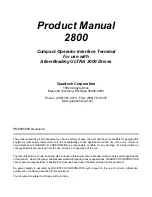
Glossary 5
RS-232 cable
A cable for serial interfaces between the terminal and communications
devices, such as a modem. The cable connects to the 25-pin serial port at
the back of the terminal. Maximum cable length is 50 feet; maximum
signaling rate is 20 Kbits/sec.
RTS/CTS flow control
Request to Send/Clear to Send flow control. Enables flow control on the
local serial line. RTS is pin 4 of the 25-pin RS232/423 connector. CTS is pin
5 of the connector. RTS is an output of the terminal; CTS is an input to the
terminal.
Serial port
A connector on a computer to which you can attach a serial line connected
to peripherals that communicate using a serial (bit-stream) protocol. The
most common type of serial port is a 25-pin D-type connector carrying
RS-232 signals. Smaller connectors (e.g. 9-pin D-type) carrying a subset of
RS-232 are often used on personal computers.
Server
The control computer on a local area network that controls software access
to workstations, printers, and other parts of the network. Under Citrix’s
server-based computing model, the server performs all application
execution functions.
SNMP
Simple Network Management Protocol. The industry standard protocol for
managing TCP/IP networks. This protocol queries agents in managed
devices and passes information to the management console.
Start bit
In asynchronous transmission, the first bit of any given character used to
alert the receiving system to recognize the related incoming data.
Stop bit
In asynchronous transmission, the last bit of any given character, used to
alert the receiving system that transmission of the character is complete.
SVGA
Super Video Graphics Adapter. A DRAM-based VGA adapter that supports
both monochrome and color high-resolution graphics and provides extended
resolutions of usually 1024 x 768.
TCP/IP
Transmission Control Protocol/Internet Protocol. The de facto standard
Ethernet protocols incorporated into 4.2BSD UNIX. TCP/IP was developed
by DARPA for Internet working and encompasses both network layer and
transport layer protocols (in the OSI model). While TCP and IP specify two
protocols at specific protocol layers, TCP/IP is often used to refer to the
entire DOD protocol suite based upon these, including Telnet, FTP, UDP and
RDP.
Telnet
Telnet is the login and terminal emulation program for Transmission Control
Protocol/Internet Protocol (TCP/IP) networks such as the Internet. Its
primary function is to allow users to log into remote host systems.
Terminal
A data terminal equipment DTE device. An input/output device made up
minimally of a video display, keyboard, and sometimes a central processing
unit, connected to a modem, for data communications.
Terminal emulator
A program that allows a computer to act like a particular brand or type of
terminal. The computer thus appears as a terminal to the host computer and
accepts the same escape sequences for functions such as cursor
positioning and clearing the screen.
Summary of Contents for 3230LE
Page 1: ...Winterm 3000 Series Windows based Terminal Users Guide Issue 070601 ...
Page 2: ...This page intentionally blank ...
Page 4: ...This page intentionally blank ...
Page 18: ...xvi This page intentionally blank ...
Page 22: ...4 This page intentionally blank ...
Page 34: ...16 Chapter 1 This page intentionally blank ...
Page 37: ...General Terminal Information 19 Figure 2 3 User Level Terminal Properties Screen ...
Page 42: ...24 Chapter 2 This page intentionally blank ...
Page 56: ...38 Chapter 4 This page intentionally blank ...
Page 64: ...46 Chapter 6 This page intentionally blank ...
Page 68: ...50 Chapter 7 This page intentionally blank ...
Page 70: ...52 Chapter 8 This page intentionally blank ...
Page 80: ...Glossary 8 This page intentionally blank ...








































